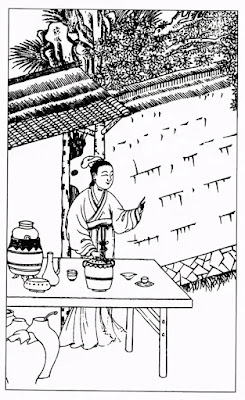Chinese painting has a thousand-year history, and it can be said that there are many types of paintings, but there is a type of painting that even children can understand, but in fact it is the opposite.
Eighteen Characters Eighteen descriptions are also known as "18 ancient and modern description methods", which were described in Zhou Lujing's "Yimen Guangmu" and Wang Keyu's "Coral Net" in the Ming Dynasty.
The "Coral Net" by Wang Keyu of the Ming Dynasty is now referred to as "18 ancient and modern description methods", referred to as 18 descriptions.
These techniques are now classified into three types: one is iron line drawing without thickness change, which is the oldest method; one is blue leaf drawing with thickness change; the other is simplified and rapid reduction of strokes.
The brush strokes are as follows: iron wire drawing (no thickness change), ancient gossamer drawing, string drawing, iron line drawing, flowing cloud and water drawing, Caoyi water drawing orchid leaf drawing (with thickness changes) earthworm
drawing, horse locust drawing Drawing, nail head mouse tail drawing, willow leaf drawing, jujube seed drawing, olive drawing, trembling pen water pattern drawing minus brush drawing (quick and simplified strokes) Among these three types, Chai drawing and brush-less drawing are similar to Cao Yi's water-
drawing and iron-line drawing. In Wang Ayu's biography, both head-pulling and brush-less drawing are from Ma Yuan and Xia Gui. In addition, there are similarities in brushwork, but in each type, there are also more prominent features, such as the vibrating pen used in the water-marking of the vibrating pen,
which is more unique. The mixed description with the wrong method of shades and shades can give play to a greater sense of space, so it is different from the general and can be called a major evolution of the line method. Unfortunately, this technique has not been developed by leaps and bounds.
Iron line drawing class The first type is the most representative iron line drawing, with uniform pressure and no change in thickness. The ancient gossamer drawing and string drawing belong to this type.
The representative painter is Gu Kaizhi, whose noble and simple brushwork can be seen from his "Women's History" and "Luo Shen Fu". The development of this line method includes the "Statues of Emperors of All Dynasties" in the Tang
Dynasty, the "Da Yingzhen Map of the Capital Increase System" in the Five Dynasties, the "Ji Qiu Niang Picture Scroll" by Zhou Lang in the Yuan Dynasty, and the "Xiangjun" in the Ming Dynasty Wen Zhengming's trembling pen. Madame Picture, Tang
Yin's "Meng Shu Palace Prostitutes", Fei Danxu's "Twelve Jinchu Atlas" in the Qing Dynasty, and the changed "Inorganic Plan", etc., you can see the origin and evolution of this line drawing method. trace.
The second largest type of line drawing is the orchid drawing. After the development of this type of line drawing, it has great vitality. Wang Ayu said: "Ma locust is called orchid leaf drawing, or willow leaves are orchid opposite drawing, I am afraid it is not the
same." Orchid leaf drawing is a drawing method that is reflected from the twists and turns of the rich clothing patterns to the back, and has its own independence. The characteristic is that the pressure
is uneven, and when the pen is moved, the strokes are suddenly thick and thin, and the lines are like orchid leaves. Jujube pit tracing and willow leaf tracing belong to this type.
The painter who represents this line method is Wu Daozi. Unfortunately, many of his works have not been handed down. We can only corroborate it slightly from the "Send Zi Tianwang Tu" and ancient
records that were made for him. The range of the transition of the line drawing is increased. According to Song Dongyu's "Guangchuan Painting Postscript", Wu Sheng's paintings are like sculptures, and he can
understand Zhou Shi and Gai Siwei. His handwriting is as thin as copper wire. The thickness of the vermilion powder shows that the bones are high and low, and the inside is rising and sinking."
There are also many successors of this description, such as Li Tang's "Caiwei Tu" in the Song Dynasty, "Yongle Palace Murals" in the Yuan Dynasty, and figure paintings by Chen Hongshou and Zhang Lu in
the Ming Dynasty and painters of the Zhejiang school, all of which are good at using the orchid leaf line drawing method. They may gallop in orchid leaves, reduce the description of Zhu, and do not create new styles.
The third type of line drawing is the reduced stroke, which is actually a variant of the development of a part of Chinese painting towards freehand brushwork.
The method is to deflect the pressure to one end and speed up the brush stroke, such as the electric light stone man, sometimes the line and the surface are combined, and the bamboo leaf drawing and the chai brush drawing belong to this type.
The representative painter of reduced strokes is Liang Kai. Liang was still basically in the stage of fine brushwork line drawing before. Since Liang Kai created the reduced brushstroke drawing, it has opened the way for the future freehand line drawing and the interactive drawing method of shades.
This kind of line drawing is very different from the general drawing method. The method first uses light ink to drum the pattern of the clothes, and then uses thick ink to separate the wrinkles of the clothes, so that the ups and downs of the clothes are clear and chaotic.





















No comments: